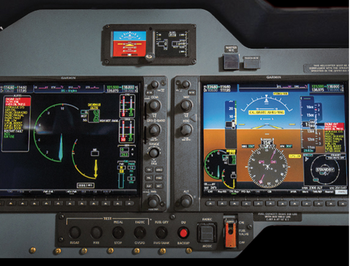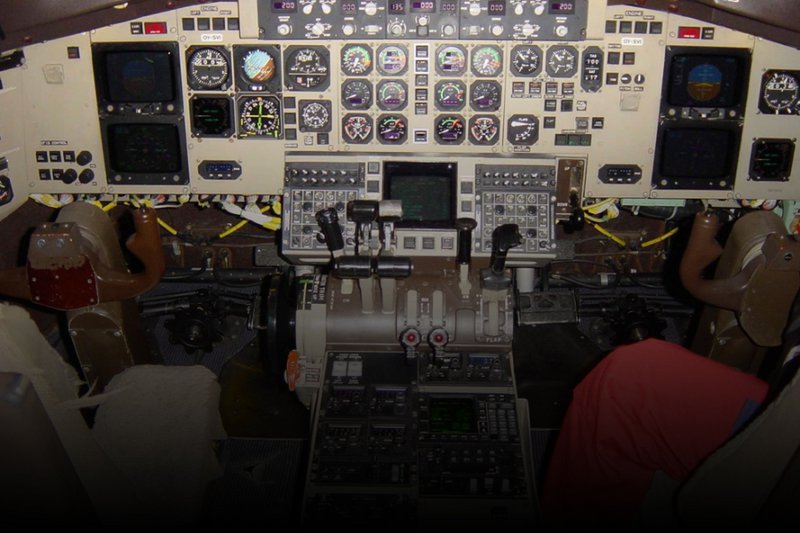

26:14 - Saleeh engages the Autopilot and flying without hands! I have to select heading first.Here in this video of my training, I tried the autopilot for the first time in my life! The Skyview has a handy W&B calculator available in the system to compute W&B based on the latest fuel load entered previously as well as the passenger weight data. Weight and balance data is an important computation that the PIC has to do to ensure the aircraft is not overloaded or the positional loads of passengers/cargo on the aircraft does not adversely affect the centre of gravity.

However any significant deviations between the two could indicate a problem with the fuel sender and alert the pilot to a possible sensor malfunction. The fuel senders are more well-calibrated and are in theory much better than the dipstick. These values have to correlate with the pilot’s physical inspection of the fuel tanks with a dipstick. This is to reconfirm the fuel computer’s assumption and fuel sender’s measurement values. Upon a cold-boot of the Skyview, this window may show up:
Glass cockpit upgrade how to#
SFC requires pilots to have a few hours of training time with an instructor before one is signed off to fly as Pilot-in-Command (PIC).įor my glass-cockpit training, I had highly-qualified flight instructor Saleeh teaching me how to use this system. I started the Skyview HDX at the 2:10 mark. Here is a video of one of my last flights on N5748E in its former steam gauge configuration. Before-after comparison of basic instrument operation Previous steam gauges It also acts as a second communication radio.Īlthough made by different manufacturers, the Skyview has the capability to interface with the GNS-430 to rely on its more-precise GPS data to display to the pilot for IFR operations like glideslope tracking. A second GPS unit Garmin GNS-430 which is IFR-capable is therefore installed. The GPS on the Skyview HDX is not certified for IFR use hence it alone cannot be used for Instrument Flight Rules (IFR) operations. This improves the situational awareness of everyone as the pilot no longer has to solely rely on ATC to detect the presence of nearby ADS-B aircraft. The plane now comes with Automatic Dependent Surveillance–Broadcast (ADS–B) transceiver to both broadcast the plane’s position and receive ADS-B signals from other aircraft.
Glass cockpit upgrade manual#
This longer manual step can take the pilot’s focus away from other tasks. The previous radio Bendix King KX-155 is an extremely basic unit which has to be manually tuned by the pilot to the correct frequency. Of course manual tuning is always available if needed.

Quick-access buttons then allow the pilot to quickly select the Tower, Ground and ATIS frequencies instead of having to do manual frequency tuning. With the fusion of the GPS data, it can suggest the nearest airports when the pilot rotates the selection knob. This new radio system has an internal database of common airport frequencies. The first radio is handled by the Skyview itself which I would consider to be a “smart” radio. There are 2 separate radio systems in this aircraft. Both the Skyview’s and EFIS-D10A’s backup batteries are independent which increases instrument power redundancy. Just like the Skyview, this EFIS-D10A is also equipped with its own backup battery in case all electrical power is lost in flight. This tiny unit alone has all the functions of the 6-pack! There are no more analog gauges, not even as standby.Īs a backup to the Skyview, the plane is equipped with an EFIS-D10A. It has also replaced avionics such as but not limited to: It has taken over all the functions of the classic 6-pack steam-gauges that the aircraft originally came with. It is a clean-sheet replacement of all the cockpit instruments previously on this aircraft. The new system is called Dynon Skyview HDX. It refers to the instrumentation that the pilot uses.Īs Wikipedia explains, “A glass cockpit is an aircraft cockpit that features electronic (digital) flight instrument displays, typically large LCD screens, rather than the traditional style of analog dials and gauges.” What has been upgraded? The term “glass” here does not refer to the material of the windshield. I had many friends from non-aviation backgrounds ask me, isn’t the windscreen already made of glass…? Prior to this, the aircraft I have flown including those in training have all used traditional steam-gauges.īut first, lets have some background info. In this blog post, I’ll like to share my learnings when transitioning to this system. Seletar Flying Club (SFC) in collaboration with MAJ Aviation recently upgraded one of its aircraft, a Cessna 172N (N5748E) to use a glass cockpit.Īs an SFC member, I had the privilege to learn about this new system and fly on this upgraded aircraft.


 0 kommentar(er)
0 kommentar(er)
